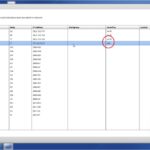A 2017 Detroit DD15 engine is experiencing low NOx conversion efficiency, triggering a check engine light and derating. The issue began last month and persists despite numerous repairs and component replacements. This article will delve into the problem, outlining the steps taken so far and exploring potential solutions for Spn 4364 Fmi 17.
Understanding the Problem: SPN 4364 FMI 17
The diagnostic trouble code (DTC) SPN 4364 FMI 17 points to a problem with the NOx conversion efficiency. Specifically, FMI 17 indicates a fault detected by the engine control module (ECM) related to the NOx sensor or the aftertreatment system. The fluctuating NOx conversion efficiency, ranging from initial readings of 95-100% down to 0% and then hovering between 20-60%, suggests an intermittent problem that is difficult to pinpoint. The derating to 55 mph is a safety mechanism activated by the ECM to prevent further damage to the engine and aftertreatment system.
Troubleshooting Steps Already Taken
Extensive troubleshooting has already been performed on the DD15 engine. Here’s a summary:
- Dealer Attempts: Initial diagnosis at a dealership led to the replacement of the outlet NOx sensor and software updates. Valve adjustments were performed due to suspected rich air/fuel mixture. The air filter and air filter box were also replaced. None of these actions resolved the issue. The dealership ultimately recommended replacing the One Box aftertreatment system.
- Owner’s Efforts: After retrieving the truck, the owner independently replaced the DEF fluid, Delta pressure sensor, MAF sensor, air intake temperature sensor, and HC doser. The DPF filters were cleaned (two were replaced the previous year), and the One Box was cleaned professionally. A new inlet NOx sensor, inlet DOC pressure sensor, hose (which was found clogged), and soot sensor were also installed. A new DEF doser and DOC face plug were also tried. Finally, the variable water pump and thermostat were replaced due to observed temperature fluctuations. Despite these extensive efforts, the problem remains.
Analyzing the Symptoms
Several key symptoms point to potential causes of the persistent low NOx conversion efficiency:
- Fluctuating NOx Efficiency: The erratic behavior of the NOx efficiency suggests an intermittent fault or a sensor issue.
- High Inlet NOx: An inlet NOx reading of 400 ppm is within a reasonable range, but the outlet NOx exceeding the inlet value indicates a problem with the NOx reduction process.
- DOC Pressure Differential: The DOC inlet pressure (0.4-0.6) being significantly higher than the outlet pressure (0.2-0.3) is expected, but the low absolute values might warrant further investigation.
Potential Causes and Further Diagnostics
Considering the steps already taken and the persistent symptoms, the following potential causes warrant investigation:
- Wiring Harness Issues: Though visually inspected, the wiring harness between the ACM and sensors, especially near heat sources, could have intermittent shorts or opens when the engine reaches operating temperature. Thorough testing with a multimeter or specialized diagnostic tools should be conducted.
- ACM Malfunction: The Aftertreatment Control Module (ACM) could be malfunctioning intermittently, leading to incorrect signals or control of the aftertreatment system. Testing the ACM with diagnostic software or replacing it with a known good unit might be necessary.
- Exhaust Leaks: While not explicitly mentioned, any leaks in the exhaust system upstream of the NOx sensors can significantly impact readings and efficiency. A thorough inspection for leaks should be performed.
- Internal DPF or One Box Issues: While cleaned, internal damage or contamination within the DPF or One Box not readily apparent during visual inspection could be contributing to the problem. More advanced diagnostic tests or specialized cleaning procedures might be needed.
Conclusion
Resolving the SPN 4364 FMI 17 issue requires a systematic approach to pinpoint the root cause. While numerous components have been replaced, focusing on potential wiring harness issues, ACM malfunction, exhaust leaks, and a more thorough examination of the DPF and One Box might provide the solution. Using diagnostic software to monitor sensor data in real-time during operation, particularly when the NOx efficiency drops, will be crucial in isolating the fault.

